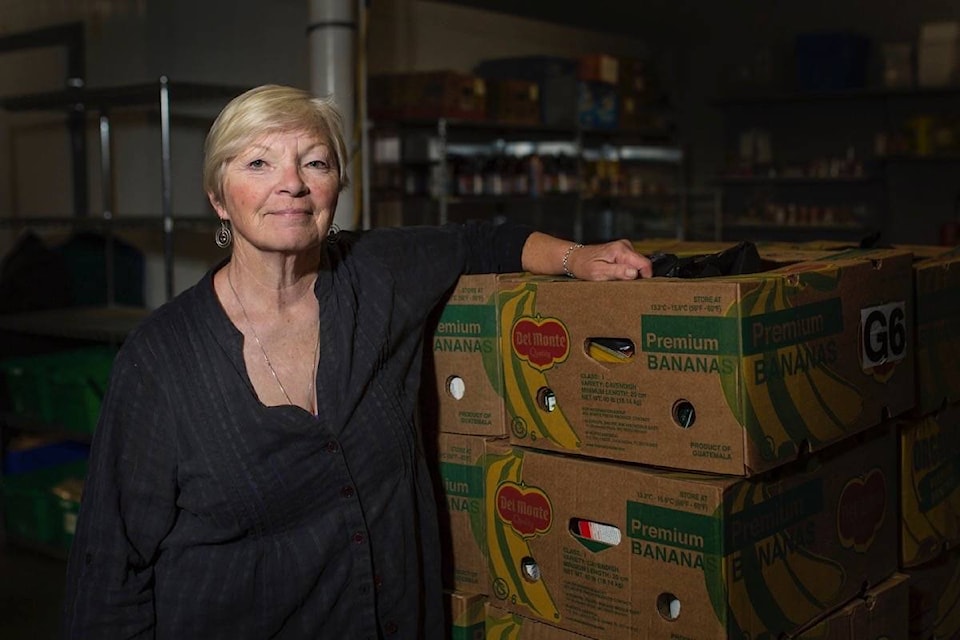The truck leaves every morning at 8. It makes a few stops, filling up its large refrigerated compartment before returning to headquarters.
Once there, the contents are weighed, sorted and shelved by faithful volunteers until the products are ready to be handed over to the Campbell River Food Bank’s clients.
Since 2015 the truck, purchased thanks to a grant and generous donations from community partners, has allowed the food bank to offer perishable goods in addition to its usual fare.
Bucking a nation-wide trend of food waste, the Campbell River Food Bank is able to turn 80 per cent of the donated food that comes through its doors into clients hands. The other 20 per cent, they offer to local farmers as food for their animals.
Food waste has become the norm in Canada, according to a landmark study from Toronto-based Second Harvest Food Rescue.
Research showed that 58 per cent of the food produced in Canada is lost or wasted. The study suggests that there’s 1.31 million tonnes of preventable food loss waste in the retail industry.
That’s where the food bank’s Food Care Food Share program comes in.
Not only is the program helping to feed our community’s vulnerable populations with fresh produce, dairy and meat products, it’s keeping the extras out of our landfills. The food bank estimates that each month, 108,000 lbs of food is saved.
On a Thursday morning this summer, the food bank is buzzing with activity. The truck has arrived and volunteers are diligently weighing the products, sorting what stays and what goes to feed animals.
Each month, around 135,000 lbs of donated food comes into the food bank.
“It sounds crazy, but nice numbers to have.” says Food Bank Manager Debbie Willis, “The food recovery program is working brilliantly.”
She moves about the warehouse with ease, sharing laughs with the volunteers.
Since its inception in 1985, the food bank has continued to grow. Two cold rooms keep the dairy and meat products from spoiling, while non-perishables line the shelves.
“We’re not doing nearly as bad as we have in the past,” says Willis.
There was a time when the food bank didn’t know if it could feed its clients. Calls for donations would go out regularly. But since 2015, when the Food Care Food Share program began, the food bank has been doing a lot better.
With daily donations from local major grocery stores, the food bank’s clients are getting fresh, healthy food rather than just ramen noodles and cans of chili or spam.
The program started with donations from Superstore of unsaleable produce and dairy, then Thrifty’s joined with dairy items. The refrigerated truck that allows the program to operate as successfully as it does, was purchased.
In 2017, donations greatly increased and began to include outdated Kraft products. Quality Foods began weekly donations of outdated and damaged products and Thrifty’s began including all departments in their donations.
Most recently, Save-on-Foods came on board with donations from all of its departments.
Consumers aren’t always keen to eat mishapen produce, even though it remains prefectly edible. Tins that a forklift may have dented are donated, rather than hitting the garbage.
The food bank serves more than 2,000 people each month and Willis says that 35 per cent of their clients are under the age of 18.
The food bank also supports a number of local network agencies including the Quadra Island Food Bank and Port Hardy’s Harvest Food Bank.
“We look after ourselves first but we also have all these agencies,” says Willis. “We’re kind of a hub.”
With the increase in fresh donations, they occasionally have more than they need. In those cases, Willis heads to her office and makes her way down a hand-written list of charitable community agencies.
She says it’s nice to be able to help them.
Even with the food bank’s success in the community and the important service it provides, it does not receive any guaranteed income.
This year, it has organized a 2020 calendar to help boost its budget.
The calendar features local scenes with images donated by community photographers. The calendars cost $15. They’re available for purchase at the food bank and community partners such as Joe’s Pharmacy and Willow Market. All the proceeds will go directly to the food bank.
RELATED: Smashing pumpkins for the Campbell River Food Bank
RELATED: Donate garden bounty to Food Bank
@marissatiel
marissa.tiel@campbellrivermirror.com
Like us on Facebook and follow us on Twitter.
